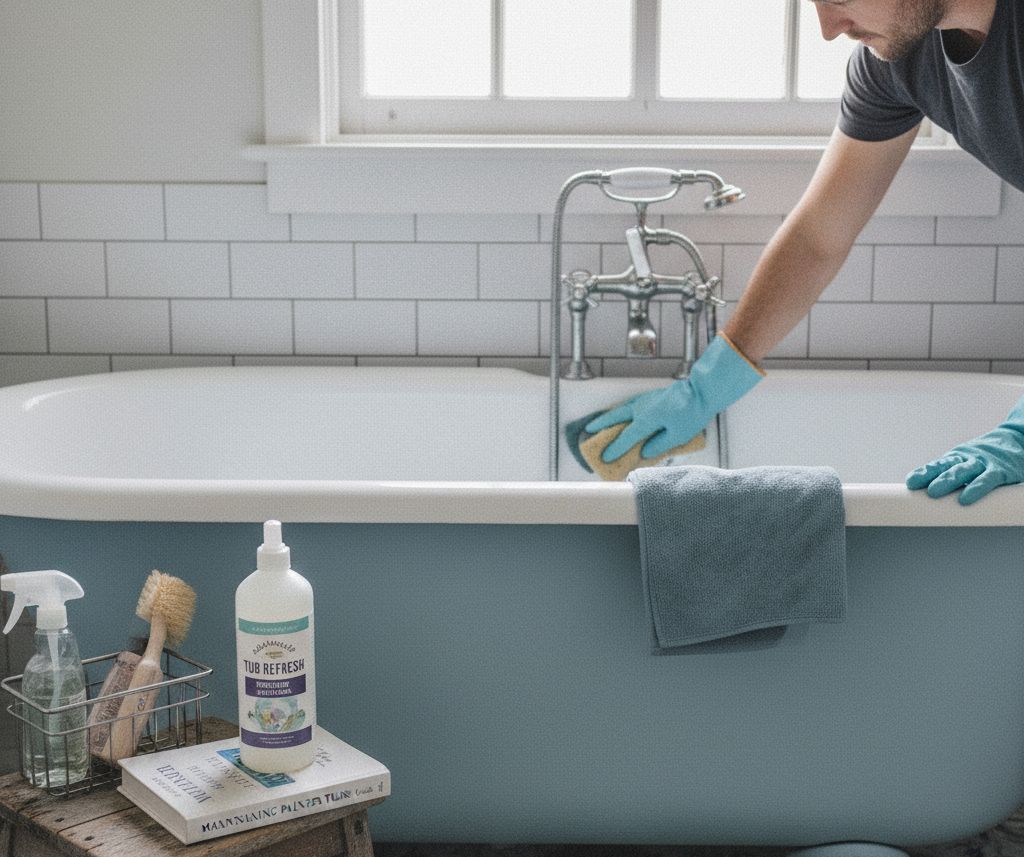Table of Contents
Introduction
Tub paint is one of the most effective solutions for giving your bathroom a professional facelift without spending thousands on a new bathtub. Over time, tubs lose their shine due to soap scum, hard water stains, and surface scratches. Replacing an entire bathtub involves demolition, plumbing, and days of labor, but with high-quality tub paint, you can achieve a near-new finish in less than a weekend. Professionals and homeowners alike now rely on tub paint to refresh worn-out surfaces at a fraction of the replacement cost.
Unlike regular wall or furniture paint, tub paints is formulated to withstand constant moisture, heat, and cleaning agents. It adheres tightly to porcelain, ceramic, acrylic, and even fiberglass tubs, creating a durable, water-resistant surface. Whether you’re a contractor managing renovations or a homeowner looking for a quick fix, understanding how to select, apply, and maintain tub paint can extend your tub’s life for years.
Understanding Tub Paint
Tub paint is a specialized coating designed for surfaces exposed to water and daily use. It typically comes in epoxy or acrylic urethane formulas. These coatings form a hard, glossy film that resists peeling and yellowing, offering a clean, polished appearance.
Professional refinishing contractors use paints systems with a primer, base coat, and curing agent. When applied correctly, the result mimics the smoothness of factory porcelain. Modern tub paints are also low-VOC and odor-reduced, making them safer for indoor projects.
Key Advantages of Tub Paint:
- Cost-effective: Refinishing costs are 70–80% less than full replacement.
- Time-saving: Most projects can be completed within 24–48 hours.
- Durability: High-quality epoxy coatings can last 10 years with proper care.
- Customizable: Available in various shades, from classic white to modern neutrals.
Types of Tub Paint
Not all tub paints are created equal. Choosing the right formula ensures both appearance and longevity.
1. Epoxy-Based Tub Paint
Epoxy is the most common and durable type of paint. It forms a thick, glossy surface resistant to chipping and chemical cleaners. Professionals prefer two-part epoxy systems that require mixing before application. Though it has a strong odor during curing, epoxy provides superior adhesion and hardness.
2. Acrylic Urethane Tub Paint
Acrylic urethane offers a slightly softer finish but is easier to apply and more flexible. It’s ideal for homeowners refinishing fiberglass or plastic tubs. This type of tub paint is also available in spray versions, allowing for a smoother, more even coating.
3. Water-Based Tub Paint
A newer alternative, water-based paints is eco-friendly and low-odor. While not as durable as epoxy, it’s a great option for minor touch-ups or low-traffic bathrooms. It’s easy to clean up with soap and water and safer for indoor environments.
Preparing Your Tub for Painting
Preparation is the most critical stage of refinishing. Even the best paint will fail without proper surface prep.
- Clean Thoroughly: Remove all soap scum, oils, and residues using a heavy-duty cleaner.
- Remove Old Coating: Sand the surface lightly to eliminate gloss and create a rough texture for the paint to grip.
- Repair Chips and Cracks: Fill imperfections with a tub repair kit and sand smooth.
- Dry Completely: Ensure the surface is free from moisture before applying primer or paint.
- Mask Surrounding Areas: Use painter’s tape and plastic sheets to protect tiles, faucets, and walls.
Professionals often recommend using an etching cleaner to improve paint adhesion on porcelain and enamel surfaces.
Applying Tub Paint Professionally
While DIY kits are popular, a professional-style finish requires patience and attention to detail.
- Prime the Surface: Apply a compatible bonding primer to ensure proper adhesion.
- Mix Components: For two-part epoxy, blend the resin and hardener precisely as per instructions.
- Apply Evenly: Use a high-density foam roller or HVLP spray gun for smooth coverage. Avoid over-brushing to prevent streaks.
- Allow Curing Time: Let each coat dry completely before applying the next layer. Most systems require 24–48 hours for full cure.
- Final Inspection: Once dry, lightly buff any imperfections with fine-grit sandpaper and polish the surface.
Maintaining a Painted Tub

Proper maintenance will determine how long your refinished tub lasts.
- Avoid harsh chemicals: Use mild, non-abrasive cleaners to preserve the coating.
- Prevent standing water: Prolonged moisture can weaken paint adhesion.
- Don’t use suction mats: They trap water and may peel the paint.
- Re-seal when needed: Apply a protective clear coat every few years for added gloss.
Professionally applied tub paint finishes can remain glossy for 8–10 years, while DIY applications may last around 5 years with good care.
Common Mistakes to Avoid
Even skilled homeowners can make errors when refinishing a tub.
- Skipping Surface Prep: Poor cleaning leads to bubbling and peeling.
- Applying Too Thickly: Heavy coats cause drips and uneven drying.
- Ignoring Ventilation: Fumes from epoxy paints can be strong; ensure airflow.
- Using Wrong Products: Not all paints labeled “bathroom safe” are suitable for tubs.
- Rushing Curing Time: Using the tub too soon can damage the finish permanently.
Professional vs. DIY Tub Painting
For property managers, landlords, or homeowners looking for high-quality results, hiring a professional refinisher can be a smart investment. Professionals use industrial-grade coatings and spray systems that create a smoother, longer-lasting finish.
DIY kits, on the other hand, are budget-friendly and practical for minor updates. However, they may lack the high-end durability of commercial products. The choice depends on your budget, skill level, and expectations.
Cost Overview
- DIY kits: $40–$100 (includes paint and applicators)
- Professional refinishing: $300–$600 on average
- Full tub replacement: $1,000–$3,000+
Tub paint offers a clear middle ground—professional-looking results at a fraction of the cost of replacement.
Conclusion
Tub paint provides an affordable, professional-grade solution for revitalizing old bathtubs without full replacement. When properly applied, it delivers durability, shine, and resistance comparable to factory finishes. For professionals in property maintenance, renovation, or interior design, it’s a cost-effective strategy to extend fixture life and enhance bathroom aesthetics.
Whether handled by a contractor or a meticulous DIYer, paint remains one of the smartest upgrades in modern home improvement — a small project with a big visual payoff.
FAQs About Tub Paint
1. How long does tub paint last?
With proper preparation and maintenance, paint can last anywhere from 5 to 10 years depending on the formula and application quality.
2. Can you use regular paint on a bathtub?
No. Regular wall or enamel paint will not bond properly and will peel under moisture and heat. Always use paint specifically designed for tubs.
3. Is tub paint safe once it cures?
Yes. After full curing, most modern tub paints are non-toxic and safe for everyday use.
4. How long before I can use my tub again?
Typically, you should wait at least 48 hours after the final coat for the surface to harden completely.
5. Can tub paint change the color of my bathtub?
Absolutely. paint comes in a variety of colors, allowing you to shift from classic white to contemporary shades like gray, beige, or even soft blue.
6. Does tub paint work on tiles and sinks too?
Many epoxy-based paints can also be used on tiles, sinks, and shower stalls for a consistent finish. Always check product labels before use.



